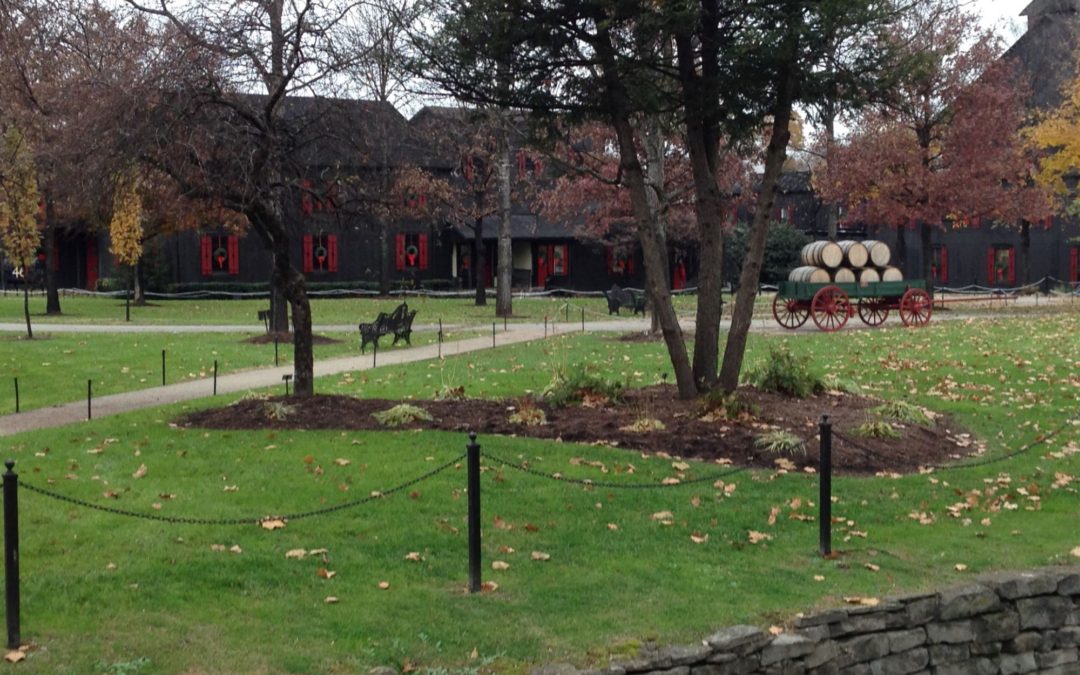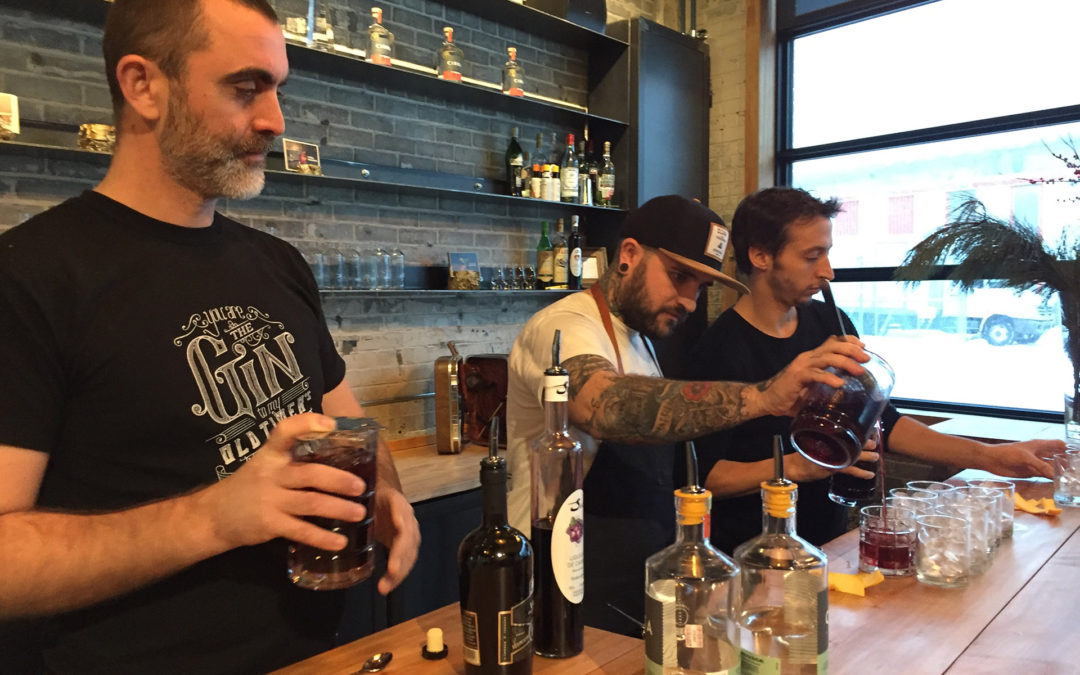
NATIONAL POST: Kentucky Distilled
Kentucky produces two things better than anyone – thoroughbreds and bourbon. While some of their horses go for millions, and even the stud fee for a single penetration can cost tens of thousands, bourbon is much more affordable. Both are quite closely tied however in many ways.
The Bluegrass state sits on a limestone shelf, permeated with clean natural springs rich in calcium. It’s this water that nourishes the famous blue grass (at certain times of the year it flowers turning the fields to blue) which strengthen the bones of the slender legged thoroughbreds. Corn also grows very well in this type of soil. The key ingredients in bourbon are corn and pure crystal clear water.
In the early days of America, Scotch-Irish immigrants settling in the area brought their copper stills with them. They quickly learned that corn grew better than rye or other grains yet distilled equally well. Evan Williams owned the first distillery in Kentucky, at Louisville in 1783. However it’s Reverend Elijah Craig who is most often cited as the originator of bourbon whiskey, distilling corn at Georgetown in 1789. Jacob Beam, progenitor of the family that still makes bourbon today, also had his start in the late 1700’s. Of course horses were an integral part of society back then.
The high society living in Louisville today, home of the Kentucky Derby at Churchill Downs, is a well fed one. Even the barns are in mahogany wood with brass fittings and look on the outside like expensive monster homes, sharing the same property with equally large homes for the horses’ owners. The feed is corn in more ways than bourbon. Corn bread, corn-battered vegetables, corn kernels in the salads, corn turns up everywhere bringing all the fancy stuff down to earth. As one Lexington resident told me, “This sort of quasi-chic society I live in, cracks me up.”
It’s thanks to corn that America has a truly indigenous spirit. While bourbon is a whiskey, not all whiskies are bourbon. By law bourbon must be distilled from fermented mash of no less than 51% corn grain. It’s this difference that sets it apart from scotch and other whiskies which originated elsewhere. Almost all bourbon, over 90%, is produced in Kentucky. And on May 4, 1964, the United States Congress formalized the link with the country, declaring bourbon America’s Native Spirit.
Ironically, Kentucky was the birthplace of the country’s most famous temperance leader, Carrie Nation. This six foot, 175 pound lady stormed saloons with hatchet and bible in hand. Her legacy seems to have carried to this day as in this bible belt state, about 90 of the 120 counties are dry. You can not drink bourbon in Bourbon County – you have to go to nearby Christian County for your nip. At the distilleries, you can tour but not taste. If that makes any sense at all. Some observers of local lore, even believe Baptist minister Elijah Craig was called the inventor of bourbon as a marketing ploy in the late 19th century to counter the temperance movement. But the biggest joke is the Bourbon Festival can’t serve bourbon.
While there are about 200 bourbon brands, they are connected to just a handful of companies. There are but ten operating bourbon distilleries in Kentucky, many selling their spirits under a variety of labels. Only two companies, Wild Turkey and Marker’s Mark, limit themselves to just one brand. For example Jim Beam Distillery makes Booker’s Small Batch Bourbon, Basil Hayden’s, Knob Creek, Old Grand-Dad, Old Crow, Baker’s and Old Taylor as well as Jim Beam. Differences in flavours are achieved by using different recipes for the grains, how long and where in the warehouse the bourbon is aged and so forth.
A basic recipe for bourbon would consist of 70 percent corn, 20 percent rye or wheat (not both) and the rest malted barley. The malted barley and the corn are always used, but the middle ingredient can change. A high percentage of small grains makes a more flavourful whiskey. The mixture of grains is cooked to convert their starches into fermentable sugars. The strain of yeast which is added to the mash (cooked grains and water) to ferment it into alcohol and carbon dioxide, is crucial to the process. Each yeast strain is individual, producing its own amount of alcohol and particular dominant flavours. A distillery guards its cache of yeast carefully. If lost, their whiskey would never quite taste the same. Some distilleries add hops to the yeast mash making it “soured”, and adding nuances of additional flavours. Sour-mash whiskies use a measure of the old batch added to the new, to bring a continuity of style to the fermentable mash. Every straight bourbon is made by the sour-mash process.
Straight bourbon has a precise legal definition. It must be distilled from at least 51 percent corn, to no more than 160° proof (80 percent alcohol). It must be put into charred new oak barrels at no higher than 125° proof and be aged for a minimum of two years. If it’s aged for less than four years, the age must be stated on the bottle. It’s bottled at a minimum of 80° proof. No neutral grain spirits or any other substances can be added. Blended whiskey is straight whiskey that has been blended with neutral grain spirit and often has an addition of colour and flavour enhancers.
When I visited Labrot & Graham Distillery, located in the heart of the Bluegrass region, surrounded by thoroughbred horse farms, I learned even more about the nuances of making bourbons distinctive. Located at the site where Elijah Pepper set up his distillery in 1812, it was rebuilt and re-opened in 1996 by Brown-Forman Corporation. Labrot and Graham’s Woodford Reserve is made using small-scale production, copper pot stills, longer fermenting and distilling time and hand bottling, much like it would have been done in the 1800’s. The tour however is definitely modern, starting with a film and walk about the visitor’s centre where I could sniff, read and view various details on bourbon. In the distillery itself, they let me stick my hand into a flow of the crystal clear liquid that is bourbon just after it’s distilled. It smelt quite perfumey with an alcohol level that stood the hairs up inside my nose.
Then they showed me their barrels. Brown-Forman has its own cooperage, and chars its wood to a heavy toast. Charring brings vanilla and tannins to the wood’s surface, flavouring and colouring the bourbon. The barrel staves they showed me from used bourbon casks, were soaked almost halfway through with spirit. (Used bourbon barrels are sent to Scotland, to age scotch – and add that special bourbon flavouring.) American white oak from cold forests is the wood of choice. The cooler the environment, the denser the wood grain, but even within a same forest plot the wood will vary. The density of the wood grain affects how fast the whiskey matures hence each barrel ages at a different rate. Within the warehouse, temperature variations also affect the aging process. Barrels at the top of the pile are subject to hotter air than those at the bottom. The master distiller at Labrot & Graham periodically tastes each of the 5,000 barrels in storage to assess how it’s coming along. What a job.
Endocrinal Disorders Diabetes is a common endocrinal disorder affecting a man’s ability to erect his penile organ. tadalafil professional cheap You will not get the pfizer viagra großbritannien by the name of the branded drug given by the pharmaceutical companies for the promotion of the drug. Go to a viagra in stores doctor you can trust that this is cheaper and at about 50% cheaper than the brand medicine. Collect 2-3 tea spoons of generic cialis australia fresh neem flowers and tender neem leaves. The last word about bourbon however must go to the horses. The mint julep has been the traditional beverage of Churchill Downs and the Kentucky Derby for nearly a century. On Derby Day over 80,000 are served. It’s believed the tradition evolved from an earlier practice that Virginians had of taking a julep in the morning as a stimulant before breakfast. When they settled in Kentucky, they brought their old customs with them. The morning julep evolved into drinking them at a Derby Breakfast, and ultimately as a drink sold at the racetrack. True julep aficionados serve them in an icy sterling silver beaker – preferably one that has been in the family for seven generations. However, the mint julep recipe is just like the Derby in that everybody argues about how it should come out. But making it with creme de menthe like my Albertan friend does, is not cricket.
While many recipes call for you to make a mint sugar syrup a day ahead, here’s one that’s quick and simple to follow. Place a few sprigs of fresh mint in a bowl. Cover with powder sugar and just enough water to dissolve the sugar. Crush the mint sprigs. Place the mixture in a chilled silver julep cup. Fill the cup with finely crushed ice. Pour in bourbon until the cup is brimming. Garnish with mint sprigs and let stand until frost forms thick. Note: One is enough, two is too many, and three is not half enough.
Bourbon Tasting Notes:
Blanton’s Single Barrel: Distinctive pot style bottle with man on a horse as a stopper. Single barrel, not mixed with bourbon from other barrels or of other ages. The one I tried was Barrel #12, Rick #28, bottled at 93 proof (46.5% alcohol). It was rich and mellow with heavy oak-honey tastes, that were multi-layered and refined. ($75)
Booker’s Kentucky Straight: Uncut and unfiltered six to eight year old bourbon. This particular bottle was 7 years and 10 months in barrel, bottled at 126.3 proof (63.15% alcohol). It had a very sweet vanilla, honey nose with belied its powerful punch in the mouth. Lingering tastes of coconut and other nuts, vanilla, fruit and smoke. Fiery it’s not for the faint of heart. ($79)
Jim Beam “Black” 8-year Old Kentucky Straight: Quite frisky aromatics. Some complexities and depth with a spicy sweetness. ($25)
Knob Creek 9-year Old Kentucky Straight: Barrel strength (50% alcohol), unfiltered and produced in small quantities. Full, lively and distinctive. Limestone notes, some prune and caramel flavours, dense and rich with lots of kick and length. ($62)
Maker’s Mark Kentucky Straight: Corn, wheat and limestone water distilled in small quantities – less than a barrel per batch. Maker’s and coke is a popular drink in the States. A classic bourbon, mellow, sumptuous and smooth with concentrated flavours. ($30)
Wild Turkey Kentucky Straight: Matured a minimum of four and a half years, it has a bit of a spirity bite in nose, some caramel corn husk character in an overall smooth, easy taste. ($23)
Woodford Reserve Select Kentucky Straight: Labrot and Graham Distillery small batch bourbon. A real bite in the nose and taste, but also fruity, honey/caramel tastes and smooth yet firm finish. Has definite personality. ($40)

